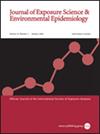Micro-nanoplastic induced cardiovascular disease and dysfunction: a scoping review
IF 4.7
3区 医学
Q2 ENVIRONMENTAL SCIENCES
Journal of Exposure Science and Environmental Epidemiology
Pub Date : 2025-04-01
DOI:10.1038/s41370-025-00766-2
引用次数: 0
Abstract
The human bioaccumulation of micro- and nano-plastics (MNPs) is increasingly being recognised in the aetiology and pathophysiology of human disease. This systematic scoping review aims to provide a comprehensive investigation of studies examining the impacts of MNPs on the human cardiovascular system. Five databases (PubMed, SCOPUS, CINAHL, Web of Science and EMBASE) were systematically searched. Forty-six articles were identified, 13 of which investigated the presence of MNPs within the human cardiovascular system, including atherosclerotic plaques, saphenous vein tissue, thrombi and venous blood. The effect of MNPs on cell lines suggest MNPs are cytotoxic, immunotoxic, and genotoxic. The findings of this review, when evaluated together with additional studies utilising animal models, suggest MNPs may contribute to global cardiovascular morbidity and mortality. In particular, the ability of MNPs to induce endothelial damage, oxy-LDL formation, foam cell development and apoptosis, as well as to alter the clotting cascade, has potential implications for vascular diseases. In addition, MNPs may play a role in the aetiology and progression of congenital heart abnormalities, infective pathologies and cardiomyopathies. Despite an increasing awareness of the ability for MNPs to result in cardiovascular disease and dysfunction, a limited amount of research has been conducted to date characterising the presence of MNPs in the human cardiovascular system. Reseach is required to understand the extent of this rapidly emerging issue and to develop strategies that will support clinicians to appropriately manage and educate their patients in the future.

微纳塑料诱发心血管疾病和功能障碍:范围综述。
背景:微和纳米塑料(MNPs)的人体生物积累在人类疾病的病因学和病理生理学中越来越被认识到。目的:本综述旨在对MNPs对人类心血管系统的影响进行全面的研究。方法:系统检索PubMed、SCOPUS、CINAHL、Web of Science和EMBASE 5个数据库。结果:共鉴定了46篇文章,其中13篇研究了MNPs在人类心血管系统中的存在,包括动脉粥样硬化斑块、隐静脉组织、血栓和静脉血。MNPs对细胞系的影响表明MNPs具有细胞毒性、免疫毒性和基因毒性。意义:本综述的发现,当与其他利用动物模型的研究一起评估时,表明MNPs可能与全球心血管发病率和死亡率有关。特别是,MNPs诱导内皮损伤、氧低密度脂蛋白形成、泡沫细胞发育和凋亡以及改变凝血级联的能力,对血管疾病具有潜在的影响。此外,MNPs可能在先天性心脏异常、感染性病理和心肌病的病因和进展中发挥作用。尽管越来越多的人意识到MNPs导致心血管疾病和功能障碍的能力,但迄今为止进行的有限的研究表征了MNPs在人类心血管系统中的存在。需要进行研究,以了解这一迅速出现的问题的程度,并制定策略,以支持临床医生在未来适当地管理和教育他们的患者。
本文章由计算机程序翻译,如有差异,请以英文原文为准。
求助全文
约1分钟内获得全文
求助全文
来源期刊
CiteScore
8.90
自引率
6.70%
发文量
93
审稿时长
3 months
期刊介绍:
Journal of Exposure Science and Environmental Epidemiology (JESEE) aims to be the premier and authoritative source of information on advances in exposure science for professionals in a wide range of environmental and public health disciplines.
JESEE publishes original peer-reviewed research presenting significant advances in exposure science and exposure analysis, including development and application of the latest technologies for measuring exposures, and innovative computational approaches for translating novel data streams to characterize and predict exposures. The types of papers published in the research section of JESEE are original research articles, translation studies, and correspondence. Reported results should further understanding of the relationship between environmental exposure and human health, describe evaluated novel exposure science tools, or demonstrate potential of exposure science to enable decisions and actions that promote and protect human health.

 求助内容:
求助内容: 应助结果提醒方式:
应助结果提醒方式:


